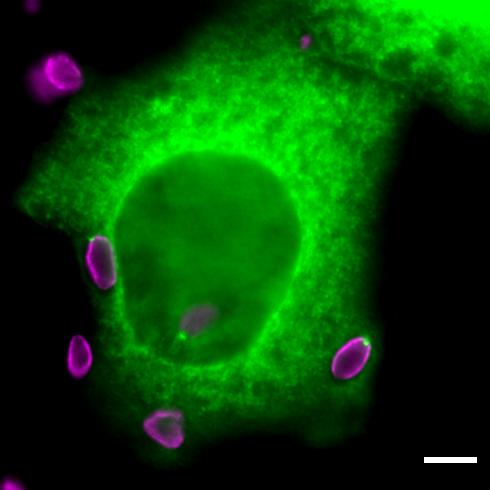Preventing the break-in of the toxoplasmosis parasite

In green, a human cell infected by Toxoplasma gondii parasite (in purple).
Credit: © UNIGE - Soldati-Favre
Scientists from the universities of Geneva and Zurich and the PSI have identified the structure and functions of RON13, an enzyme of the toxoplasmosis parasite that is essential for the infectious mechanism in humans.
Toxoplasma gondii, the parasite responsible for toxoplasmosis, is capable of infecting almost all cell types. It is estimated that up to 30% of the world’s population is chronically infected, the vast majority asymptomatically. However, infection during pregnancy can result in severe developmental pathology in the unborn child. Like the other members of the large phylum of Apicomplexa, Toxoplasma gondii is an obligate intracellular parasite which, to survive, must absolutely penetrate its host’s cells and hijack their functions to its own advantage.
Understanding how the parasite manages to enter host cells offers new opportunities to develop more effective prevention and control strategies than those currently available. A team from the University of Geneva (UNIGE), in collaboration with the University of Zurich (UZH) and the Paul Scherrer Institute (PSI) in Villigen, Switzerland, have identified the key role of RON13, a protein of the parasite, which is essential for the invasion process. The three-dimensional structure and the site of action of this enzyme are atypical, thus offering the possibility of designing specific inhibitors to stop the infection. These results are published in the journal Nature Communications.
Specific types of enzymes named kinases are key regulators of a wide range of basic biological processes. “These enzymes modify proteins by adding or removing phosphate groups that, like a switch, turn cellular functions on or off as needed”, explains Oscar Vadas, a lecturer in the Department of Microbiology and Molecular Medicine at UNIGE Faculty of Medicine, a specialist in protein biochemistry and co-author of this study.
“Kinases are great targets for drug development because, on the one hand, they are relatively easy to inhibit and, on the other hand, they are involved in many pathologies. They are therefore the subject of intense research.” Identifying a kinase essential to the survival of a pathogen would thus pave the way for the development of new therapies.
A kinase seen from all its angles
The identification of RON13, a Toxoplasma gondii kinase, quickly became a very attractive subject of study in light of its major role in the invasive capacity of the parasite. “To understand the biological processes controlled by this enzyme, both at the cellular and molecular level, we combined several state-of-the-art technologies”, explains Professor Adrian Hehl of UZH. Cryo-electronic microscopy identified an additional modular structure that was absent in all other kinases previously studied, but essential for RON13 activity. Expansion microscopy demonstrated morphological changes in the parasite using high-resolution images. In addition, proteomics was used to identify the kinase targets that are released into host cells to promote its invasion, and genetics was performed to study the impact of the absence of this kinase on the parasite’s growth.
“These sophisticated analyses were also made possible thanks to the high-precision technology facilities of the UNIGE Faculty of Medicine, which were made available to the research teams”, says Dominique Soldati-Favre, Director of UNIGE Faculty of Medicine Department of Microbiology and Molecular Medicine, who directed this work. “By pooling together all our expertise, we were able to identify precisely the interactions at work and understand the structure of this kinase at the atomic level”, underlines Volodymyr Korkhov, a professor at PSI.
Without RON13, there is no invasion
RON13 is a kinase located in a unique compartment of the parasite, an organelle containing proteins to be injected into the host. Without RON13, host cells infection is impossible. “To confirm these results, we infected mice with a strain of the parasite that does not express RON13: it became completely harmless, to the extent that the mice did not show any specific immune response”, explains Dominique Soldati-Favre.
Moreover, these very particular characteristics make RON13 insensitive to an inhibitor that is effective on the majority of kinases. “From a therapeutic point of view, this is excellent news”, says Oscar Vadas. “This means that we can target it very precisely without affecting human kinases, thus limiting the side effects of the treatment.” Moreover, although this work focused on the toxoplasmosis parasite, other pathogens of the Apicomplexa phylum share the same invasion process. It is therefore conceivable that a kinase similar to RON13 plays an essential role in infection by other parasites, and in particular by Plasmodium falciparum, the agent responsible for malaria.
This work was carried out thanks to the support of the Carigest SA Foundation and the Swiss National Science Foundation (SNSF).
All latest news from the category: Health and Medicine
This subject area encompasses research and studies in the field of human medicine.
Among the wide-ranging list of topics covered here are anesthesiology, anatomy, surgery, human genetics, hygiene and environmental medicine, internal medicine, neurology, pharmacology, physiology, urology and dental medicine.
Newest articles

Innovative 3D printed scaffolds offer new hope for bone healing
Researchers at the Institute for Bioengineering of Catalonia have developed novel 3D printed PLA-CaP scaffolds that promote blood vessel formation, ensuring better healing and regeneration of bone tissue. Bone is…

The surprising role of gut infection in Alzheimer’s disease
ASU- and Banner Alzheimer’s Institute-led study implicates link between a common virus and the disease, which travels from the gut to the brain and may be a target for antiviral…

Molecular gardening: New enzymes discovered for protein modification pruning
How deubiquitinases USP53 and USP54 cleave long polyubiquitin chains and how the former is linked to liver disease in children. Deubiquitinases (DUBs) are enzymes used by cells to trim protein…



